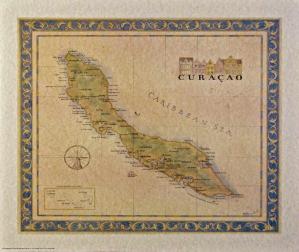
Curaçao is a long, arid, and generally flat island, stretching some 40 miles (64 km) from southeast to northwest, at much the same north-south angles as it's sister islands in the ABC group (Aruba to the west and Bonaire to the east). The island is about 10 miles (16 km) at it's widest point, and the area is about 180 square miles (472 square km), making it the largest island in the Kingdom of the Netherlands.
The coastline along the south is irregular, peppered with small bays and inlets, including the spectacular bays and beaches at the west end of the island. The largest bays are located along the central-east and east end of the island, where you'll find the capital and major port of Willemstad. Most of Curaçao's 130,000 residents live in and around this historic town.
The long north coast of the island, buffeted by constant northeast trade winds, is characterized by a rough coasthne, limestone cliff formations set on top of eons-old volcanic rock, and weather-beaten terrain. It is generally less inhabited than the south coast, but you will find smaller villages and many of the island's famous landhuis, or old plantation house, structures here.
The west end of the island is also characterized by expansive, hilly terrain, most of it encompassed by Christoffel Park. The 4,500-acre (1,820-hectare) park contains Mt. Christoffel, at 1,239 feet (377 meters) the highest elevation on Curacao. The east end of the island comprises flat and mostly barren plain, with few settlements and some secondary roads weaving to and from its coastal inlets.
With an average 20 inches (510 mm) of rainfall yearly, Curaçao is generally a dry island. There are few standing bodies of water save some saline ponds, and most of the island's water is provided by a large desalinization plant found on the south coast.
Why Curaçao?
The coastline along the south is irregular, peppered with small bays and inlets, including the spectacular bays and beaches at the west end of the island. The largest bays are located along the central-east and east end of the island, where you'll find the capital and major port of Willemstad. Most of Curaçao's 130,000 residents live in and around this historic town.
The long north coast of the island, buffeted by constant northeast trade winds, is characterized by a rough coasthne, limestone cliff formations set on top of eons-old volcanic rock, and weather-beaten terrain. It is generally less inhabited than the south coast, but you will find smaller villages and many of the island's famous landhuis, or old plantation house, structures here.
The west end of the island is also characterized by expansive, hilly terrain, most of it encompassed by Christoffel Park. The 4,500-acre (1,820-hectare) park contains Mt. Christoffel, at 1,239 feet (377 meters) the highest elevation on Curacao. The east end of the island comprises flat and mostly barren plain, with few settlements and some secondary roads weaving to and from its coastal inlets.
With an average 20 inches (510 mm) of rainfall yearly, Curaçao is generally a dry island. There are few standing bodies of water save some saline ponds, and most of the island's water is provided by a large desalinization plant found on the south coast.
Why Curaçao?
- Stable government, Curaçao is part of the Dutch Kingdom.
- Curaçao is attractive for investors: great location, a stable democracy, no hurricanes, modern facilities and constant economic growth.
- Offshore banking available. Many multinationals have established their headquarters in Curaçao.
- The current economic growth is expected to last at least another 10 to 15 years. This results in higher incomes and high return on investment.
- The Netherlands Antilles guilder has been pegged to the US dollar at the exchange rate of US$ 1.00= ANG. 1.78.
- The island has a tropical climate. The sun always shines, the average temperature is 80°F (27°C) and there are constant cool breezes.
- Curaçao is home to people of more than 50 nationalities!
- Low tax rates and attractive real estate prices.
- Curaçao has many beautifully restored monumental buildings, cruise ships arrive weekly at one of the terminals in Willemstad. White beaches and crystal clear water make the island popular with divers from the all over the world.
- More and more airlines offer direct flights to Curaçao.
- Standing and Poor's Rating Services give Curaçao an A-rating on June 14, 2013. Quote: "The ratings on Curaçao are supported by its stable democratic parliamentary system and rule of law within the Kingdom of the Netherlands, its prosperous economy, high level of social development, and strong government balance sheet".
- More information about Curaçao, its colorful history, the origins of Willemstad and our people and culture can be found here: www.curacao.com

